Designing Orthotics for Young Patients with Cerebral Palsy
3D-printed braces are being used to help children with the movement disorder.

A 3D-printed arm brace in action.
Inside the MakerSpace at Tandon’s MetroTech Center, Victoria Bill, MakerSpace Manager, and Gabriella Cammarata, recent graduate of the Integrated Digital Media master’s program, are leading a Vertically Integrated Project (VIP) class in which students 3D print braces for children living with cerebral palsy. According to the Centers for Disease Control, “cerebral palsy (CP) is the most common motor disability in childhood…[affecting] from 1.5 to more than 4 per 1,000 live births or children of a defined age range.”1
The project began in 2016, when faculty from NYU Langone Health, the Rusk Rehabilitation team, and the NYU Ability Project approached the MakerSpace for their expertise on 3D printing. Teaming up with occupational therapists and working with patients selected by Rusk, members of Tandon’s VIP class, 3D Printed Biomedical Devices, get to combine patient interaction with technological advancement to directly help a child with CP.
Read more at The Download.





